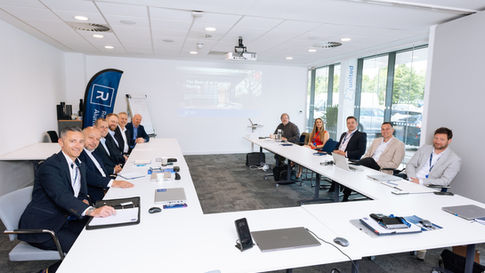Saint-Gobain Interior Solutions is helping to lead the charge in tackling the current construction skills shortage. Here, Head of Training Academies James Maclean offers insight into the factors surrounding the issue and how we can bridge the skills gap.
The construction industry faces a significant challenge – a widening skills gap that demands 937,000 new workers by 2032. This issue has many contributing factors; one-third of the current workforce, who are over the age of 50, are expected to retire within the next decade. This, along with Brexit and the COVID-19 pandemic, has significantly shaken up the construction industry, increasing the existing skills gap and highlighting the urgent need for targeted intervention to address the widening difference between skilled labour supply and industry demand.
One major challenge has been attracting young talent to the construction sector. Industry research has identified that only 6% of 18 to 24-year-olds see construction as a potential career choice, with 98% of young women feeling they wouldn’t want a career in construction.
With other sectors often seen as more appealing and construction misunderstood as manual and low-tech work, engaging the next generation has become increasingly challenging. More needs to be done across all areas of construction, including specifiers, engineers, contractors, skilled tradespeople and project managers, to make it a more attractive industry to work in.
Being proactive
Saint-Gobain Interior Solutions has created initiatives such as the Build Better Academy, recognising the pivotal role of education and training in nurturing a skilled workforce. Providing accessible and comprehensive training programmes can empower individuals with the specialised skills and knowledge crucial for excelling in the interior solutions industry.
The Academy offers a blended learning model combining digital platforms with practical, hands-on training, to cater to diverse learning styles and ensure learners gain theoretical understanding and practical skills. Using interactive e-learning modules alongside immersive workshops and simulations helps bridge the gap between classroom education and real-world challenges.

Investing in education and training also promotes a culture of continuous learning and professional development that can help companies can attract and retain top talent.
One way many are responding to this issue is by focusing on reskilling, which equips workers with competencies aligned with emerging technologies and sustainability practices, as well as advanced tools such as BIM or robotics. This helps reduce reliance on outdated methods, boosts productivity and enables the industry to meet complex project demands and environmental standards.
Collaboration is vital
Closing the skills gap cannot be achieved alone; collaboration is fundamental in the industry’s battle to tackle the skills shortage. Our Thistle Partnership Scheme, a testament to the industry’s collective efforts, has significantly expanded its support to various colleges and students throughout the past academic year.
From April 2023 to April 2024, our academy trained 2,362 students. We have also allocated resources from the Saint-Gobain Levy to assist one of our key contractors, sponsoring 10 apprentices annually with an investment of £140,000.
We’ve also made significant contributions to charitable causes, including Women into Construction, where 18 female learners received specialised plastering training. Partnerships with the Construction Youth Trust and YouthBuild have also enabled 60 learners to explore retrofit solutions.
These partnerships serve as a catalyst for aligning qualifications with the evolving needs of the construction landscape. In an industry where skills requirements are constantly changing, it’s essential to ensure that workforce skills remain relevant and current. Through collaborative initiatives, companies can collectively identify emerging skills gaps, develop tailored training programmes and advocate for industry-wide standards and certifications.
By fostering a culture of cooperation and knowledge sharing, companies can tackle systemic issues such as inadequate education and training infrastructure, limited access to resources and shifting workforce demographics. Collaborative efforts aim to create holistic solutions that address underlying structural challenges rather than merely treating symptoms.
Fostering a culture of innovation and collaboration is key to addressing the skills gap; prioritising ongoing training, mentorship programmes and recognition initiatives all help retain skilled workers and build loyalty.
.png)








































.png)










